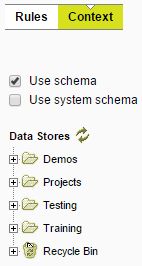Context
The schema entities and relationships defined for a data store are known as the context.
Context helps you when authoring rules
Without a context, the names of classes or attributes have to be typed by hand. With context selected, they can be chosen from lists based on the schema of the data stores selected.
Note: The context is not used when running the rules
The Context tab is found within the Navigation Pane of

The Context tab within the Rules interface
Note: If the context is updated in the Rules interface, it will also be updated in the Actions interface. You cannot have different context for Rules and Actions.
Use Schema
If Use schema is selected, a list of available data stores will appear.
Note: Multiple data stores can be selected for the context.
Once at least one data store is selected from the list, available classes will be available to be selected as parameters for:
- All conditions except Test in Range and the logical operators
- Any of the following operations:
- Loop Over Objects
- Loop Over a Collection
- Create Object
- Delete Object
- Any of the following values:
- Dynamic Value
- Object or Element
- Class Name
- Nested Value
- Array Element
- Aggregate Value
Note: For values, attributes are also available when the context is defined.
Use System Schema
If Use system schema is also selected, the system schema can also be used in rule authoring. This includes the topological classes sys:node, sys:edge and sys:face (see Topology Primitives), and the sys:connection_graph class used for querying networks (see Validating Network Graphs).



